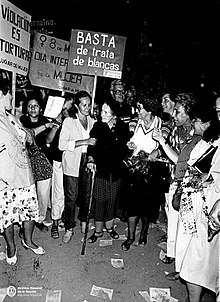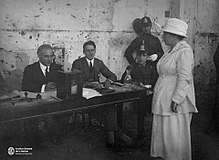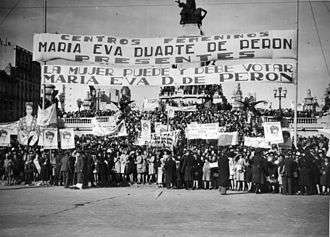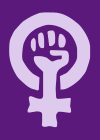Feminism in Argentina

Historically, Argentine law established a difference between the sexes. The law excluded her from the management of family property. The woman participated in the increase in value of the family property, but received only half the increase. A study in 1919 found great discrimination in the workplace, with women being badly underpaid, having to work long hours with no privileges, and receiving less wages than men. This spurred demand for specific laws to protect women's rights. The Female Peronist Party was founded by Eva Perón in the late 1940s. At that time women were not allowed to vote. In the first elections (in 1951) in which women could run for office, 24 were elected to the Argentine Chamber of Deputies, all Peronists, and seven female senators were elected, making Argentina the country with the most women representing the government. Following the death of Eva Perón, Delia Parodi, one of those deputies, led the party until the military coup of 1955
History
Precursors
Born in Buenos Aires on June 26, 1819, Juana Manso was a writer, translator, journalist, teacher and precursor of feminism in South America.[1] In fact, she is considered by many as the first feminist of Argentina.[2] She wrote in 1853: "There will come a day when the people's code will guarantee women the rights of their freedom and their intelligence. Humanity can not be retrograde."[3] Manso lived in Rio de Janeiro from 1849 to 1853, where she published The Women's Journal (Portuguese: O Jornal das Senhoras), a periodical modeled on an English magazine of the same name that, "argued against discrimination against women and supported equal education for Latin American women."[4]
First-wave

Feminism in the country emerged at the end of the 19th century and the beginning of the 20th century, during the consolidation of the modern Argentine State.[5] There was not a homogenous feminist movement, rather individual struggles carried out by women inserted in diverse political identities and different social classes. Women from the upper and upper middle class made important advances in the public space, although they did it fundamentally from the academic field.[6] Working class women were organized under socialism and anarchism.[7] A group of anarchist women headed by Virginia Bolten founded La Voz de la Mujer in 1896, the first feminist newspaper in Argentina. It defined itself as anarcho-communist and was released under the motto "No God, no master, no husband".[8] As one of the first recorded instances in Latin America of the fusion of feminist ideas with a revolutionary and working class orientation, La Voz de la Mujer differed from the feminism found elsewhere in the region at that time, which focused on educated middle-class women and their concerns.[9] By the end of the 19th century, these anarchists raised issues as free love, divorce and allegations of domestic violence, which would gain public prominence decades later.[10]

From the turn of the century on, a different variant of feminism emerged, that of the Socialist Party, with women such as Cecilia Grierson, Alicia Moreau de Justo and Juana Rouco Buela; who "launched the struggle for equal rights, better educational opportunities, and reform of the civil code, and in so doing they radically redefined the politics, strategy, and terrain of feminist struggle."[9] The first feminists of the country, both the reformists as well as the suffragettes and even those of more extreme positions, believed in a "maternal, morally superior, and pacifist feminine nature."[11] Mayra Leciñana of Clarín wrote that "the theoretical alliances with socialism and the positivism of the moment enable a utopian bias that gives thickness to their demands and allows the production of new meanings for 'the new woman'."[11] A "transcendental" figure in the history of Argentine feminism, Elvira López became one of the first women to graduate from the University of Buenos Aires' School of Philosophy and Philology.[12] Her thesis, written in 1901 and titled "The feminist movement" (Spanish: "El movimiento feminista"), is considered a local landmark and meant the issue's entry into the Argentine academic field.[11][12] In 1902, López and Elvira Rawson de Dellepiane founded the Association of University Women (Spanish: Asociación de Mujeres Universitarias).[12]
In February 16, 1906, Rawson de Dellepiane founded the Feminist Center (Spanish: Centro Feminista) in Buenos Aires, joined by a group of prestigious women.[13]
The Socialist Party has had considerable strength in Buenos Aires in the early 20th century. From 1918 or 1919 to 1922, the movement developed rapidly, and there were some 280,000 inscribed members in this movement among the laboring classes.
The Consejo Nacional de Mujeres was one of the most dignified and progressive of the women's organizations. It made a careful study of women's movements in different parts of the world and invited distinguished lecturers to appear before it. One of the most important lectures delivered before this body was that by Dr. Ernesto Quesada, the Argentine sociologist. Quesada advised the women of Argentina to work first on an educational program and, after they have attained equality before the law, then to take up the matter of political equality.
One of the most active of all Argentine women's organizations was the Club de Madres of Buenos Aires. The president of this organization was Dr. Ernestina Lopez de Nelson, the wife of Prof. Ernesto Nelson, an educationalist.
Historically, Buenos Aires was one of the worst centers for white-slave trade. Probably for that reason the women of the city became particularly interested in the movement for the single standard. Blanca C. De Hume made important contributions by her writings toward the solution of this problem.

As early as 1912, some of the farseeing women of Buenos Aires were making scientific studies of the condition of women workers. Carolina Muzilli published such an investigation for an exposition on social service in Ghent, Belgium, which was highly commended by the Government officials of her city. Her most interesting survey showed that even in 1919, there was a large number of women working in shoe factories, garment factories, and many other kinds of small factories in Argentina. As far as statistics were available, there were shown to be at that time 205,851 women wage earners in factories and commercial houses of Buenos Aires. These women were badly underpaid, having to work long hours with no privileges whatever, and always receiving less wages than men. When Muzilli began her investigations, she found prejudice so great that it was impossible to obtain data until she had gotten work in one of the factories. For several months, she continued in these activities until she brought out this remarkable survey of the condition of working women, one of the very few scientific studies of industrial conditions for women ever made in Latin America at that time.
Argentine law established a difference between the sexes against woman. The law limited her condition, excluding her from the management of family property, which, without condition, must be given into the hands of the husband. If the husband wastes the common property, the wife may solicit separation of their properties, if she has not, as is usually the custom on being married, assigned to her husband all property rights. The woman participated in the increase in value of the family property; but where there is a separation of this property she received her personal property again and only half of the increase. Laws granted, under certain conditions, the separation of husband and wife, but incapacitated them from marrying again.
The following were the demands of the Woman's Bights Association of Buenos Aires: 1. That all laws be repealed which establish a difference between the two sexes and against woman, in order that the latter may become fully competent before the law. 2. That women have the right to hold public office and especially to become members of the national and regional councils on education. 3. The establishment of special courts for children and women. 4. Passing of laws for the protection of maternity and for legitimatizing all children. 5. That all legal prostitution be abolished and that the single standard for both sexes be established. G. Equality of wages. 7. Equal political rights.
The Young Women's Christian Association, which was organized in Buenos Aires for a number of years, did much toward awakening women to new interests in life. Although suffering from small quarters, they gathered round them a number of the prominent women of Argentina, who helped them in the conducting of night classes, gymnasium, cafeteria, and other services for girls working in stores and offices, and in the study of the general means of improving the womanhood of Argentina.
Temperance was important to the women of Buenos Aires. This became such an important work that they planned, with the aid of some North American societies, to erect a temperance building in Buenos Aires to house the various activities along these lines.[14]
Partido Peronista Femenino
The Female Peronist Party, also known as the Feminist Peronist Party and the Peronist Feminist Party, was the women's wing of the Peronist Justicialist Party of Argentina. It was founded by Eva Perón in the late 1940s. After the Peronist Feminist Party was founded, twice the number of women were allowed to attend university.[15] With the set up of the Peronist Feminist Party, women's centres were set up in poor Argentinian neighbourhoods. These centres provided a wide range of services including medical, legal and social services.[15] At the time of the party's founding, women were largely absent from the political process in Argentina and were not allowed to vote.
In the first elections (in 1951) in which women could run for office, 24 were elected to the Argentine Chamber of Deputies, all Peronists.[15] Also, seven female senators were elected, making Argentina the country with the most women representing the government.[15] Following the death of Eva Perón, Delia Parodi, one of those deputies, led the party until the military coup of 1955.
Fundación Mujeres en Igualdad
The Fundación Mujeres en Igualdad (MEI), known in English as the Women in Equality Foundation, is an Argentine NGO created in March 1990. It has been awarded consultative status with United Nations ECOSOC.[16] The foundation sets out to combat gender based violence and discrimination against women by promoting welfare, participation and empowerment in the political, economic, social and cultural spheres.[17] From its inception Women in Equality promoted the use of the new technologies intensively, being the first women´s NGO in Argentina to have a website. Through such initiatives it has networked and created partnerships with NGOs and with the women's movement both at the national and international levels.[18]
Notes

- Will Fowler. Latin America: since 1780. Hodder Education. 2008. p. 116
- ↑ López, Alberto (June 26, 2017). "Juana Manso, comprometida con la educación para erradicar la pobreza". El País (in Spanish). Retrieved April 29, 2018.
- ↑ "Juana Manso, luchadora por la educación y los derechos de la mujer". Clarín (in Spanish). June 26, 2017. Retrieved April 29, 2018.
- ↑ Pigna, Felipe (July 30, 2018). "Ellas hacen historia". Caras y Caretas (in Spanish). Retrieved August 2, 2018.
- ↑ Carlson, 2005. p. 67
- ↑ Barrancos, Dora. "Los caminos del feminismo en la Argentina: historia y derivas" (in Spanish). Voces en el Fénix. Plan Fénix. Retrieved March 27, 2018.
- ↑ Macoc, 2011. p. 157
- ↑ Macoc, 2011. p. 158
- ↑ Pigna, Felipe (October 1, 2017). "Las pioneras del feminismo en la Argentina". Clarín (in Spanish). Retrieved March 27, 2018.
- 1 2 Molyneux, Maxine (1986). "No God, No Boss, No Husband: Anarchist Feminism in Nineteenth-Century Argentina" (PDF). Latin American Perspectives. 13 (48): 119–145. Retrieved March 30, 2018.
- ↑ "Vida pública: Feminismo". Mujeres 1810-2010 (in Spanish). Casa Nacional del Bicentenario. Secretariat of Culture. March 2010. Retrieved March 28, 2018.
- 1 2 3 Leciñana, Mayra (March 19, 2010). "Una historia del feminismo argentino escrita en 1901" (in Spanish). Clarín. Retrieved April 10, 2018.
- 1 2 3 Soriano, Fernando (March 8, 2018). "Las increíbles historias de 30 íconos del feminismo de todos los tiempos" (in Spanish). Infobae. Retrieved April 10, 2018.
- ↑ Riviere, Rolando (February 1960). "Pioneras del feminismo argentino". Revista Vea y Lea (in Spanish). Retrieved March 27, 2018.
- ↑ Pan American Union (1922). Bulletin of the Pan American Union. 54 (Public domain ed.). The Union. pp. 358–.
- 1 2 3 4 Fowler, Will. Latin America since 1780. Second Edition. (UK: Hodder Education) 2008. p.116
- ↑ "Women in Equality Foundation". Women in Equality Foundation. 8 April 2016.
- ↑ "Mujeres en Igualdad. Nuestros Temas". 8 April 2016.
- ↑ "Contra toda clase de maltrato". 8 April 2016.
References
- Carlson, Marifran (August 1, 2005). ¡Feminismo!: The Woman's Movement in Argentina. Chicago Review Press. ISBN 978-0897331685. Retrieved May 24, 2018.
- Jaquette, Jane (March 9, 2018) [1994]. The Women's Movement In Latin America: Participation And Democracy, Second Edition. Routledge. ISBN 978-0813384887. Retrieved May 26, 2018.
- Lavrin, Asunción (1998) [1995]. Women, Feminism, and Social Change in Argentina, Chile, and Uruguay, 1890-1940. University of Nebraska Press. ISBN 978-0803279735. Retrieved May 26, 2018.
- Lorenzo, María Fernanda (June 21, 2017) [2016]. “Que sepa coser, que sepa bordar, que sepa abrir la puerta para ir a la universidad” (in Spanish). Editorial Eudeba. ISBN 978-9502325712. Retrieved May 26, 2018.
- Macoc, Lucía (June 2011). "Feminismo e Identidades políticas a principios del siglo XX en la Argentina: Construcciones discursivas sobre la Mujer en el socialismo y el anarquismo" (PDF). Cuadernos del CIESAL (in Spanish). UNR (9). ISSN 1853-8827. Retrieved September 19, 2018.
- Nari, Marcela M. A. (2004). Políticas de maternidad y maternalismo político: Buenos Aires, 1890-1940 (in Spanish). Routledge. ISBN 978-9507864254. Retrieved May 26, 2018.

